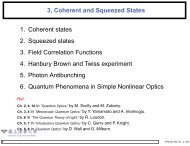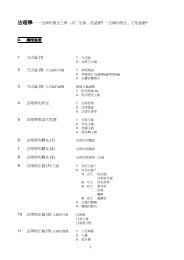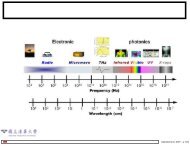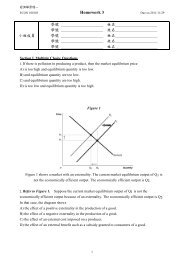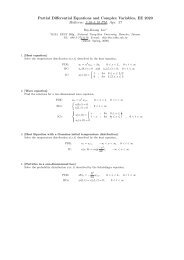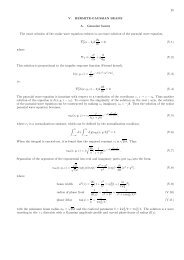Acceleration, Shock and Vibration Sensors
Acceleration, Shock and Vibration Sensors
Acceleration, Shock and Vibration Sensors
Create successful ePaper yourself
Turn your PDF publications into a flip-book with our unique Google optimized e-Paper software.
<strong>Acceleration</strong>, <strong>Shock</strong> <strong>and</strong> <strong>Vibration</strong> <strong>Sensors</strong><br />
Accelerometer mounting may have an effect on the selection process. Most manufacturers<br />
offer a variety of mounting alternatives. Accelerometers can be stud mounted,<br />
adhesively mounted or magnetically mounted. Stud mounting provides the best stiffness<br />
<strong>and</strong> highest degree of accuracy, while adhesive mounts <strong>and</strong> magnetic mounting<br />
methods offer flexibility <strong>and</strong> quick removal options.<br />
There are a wide variety of accelerometers to choose from. More than one will work<br />
for most applications. In order to select the most appropriate accelerometer, the best<br />
approach is to contact an accelerometer manufacturer <strong>and</strong> discuss the application.<br />
Manufacturers have trained application engineers who can assist you in selecting the<br />
sensor that will work best for your application.<br />
5.4 Applicable St<strong>and</strong>ards<br />
In order to verify accelerometer performance, sensor manufacturers will test various<br />
characteristics of the sensor. This calibration procedure serves to help both the manufacturer<br />
<strong>and</strong> the end user. The end user will obtain a calibration certificate to confirm<br />
the accelerometer’s exact performance characteristics. The manufacturer uses this<br />
calibration procedure for traceability, <strong>and</strong> to determine whether the product meets<br />
specifications <strong>and</strong> should be shipped or rejected. It can be viewed as a built-in quality<br />
control function. It provides a sense of security or confidence for both the manufacturer<br />
<strong>and</strong> the customer.<br />
However, be aware that all calibrations are not equal. Some calibration reports may<br />
include terms such as “nominal” or “typical,” or even lack traceability, or accredited<br />
stamps of approval. With the use of words like “nominal” or “typical,” the manufacturer<br />
does not have to meet a specific tolerance on those specifications. This helps the<br />
manufacturer ship more products <strong>and</strong> reduce scrap, since fewer measured specifications<br />
means fewer rejections. While this provides additional profit for a manufacturer,<br />
it is not a benefit to the end customer. Customers have to look beyond the shiny paper<br />
<strong>and</strong> cute graphics, to make sure of the completeness of the actual measured data contained<br />
in each manufacturer’s calibration certificate.<br />
Due to the inconsistency of different manufacturer’s calibration techniques <strong>and</strong><br />
external calibration services, test engineers came up with st<strong>and</strong>ards to improve the<br />
quality of the product <strong>and</strong> certification that they receive. MIL-STD-45662 was created<br />
to define in detail the calibration system, process <strong>and</strong> components used in testing,<br />
along with the traceability of the product supplied to the government. The American<br />
National St<strong>and</strong>ards Institute (ANSI) came up with its own version of specifications<br />
labeled ANSI/NCSL Z540-1-1994. This ANSI st<strong>and</strong>ard along with the International<br />
Organization for St<strong>and</strong>ards (ISO) 10012-1, have been approved by the military as<br />
153








